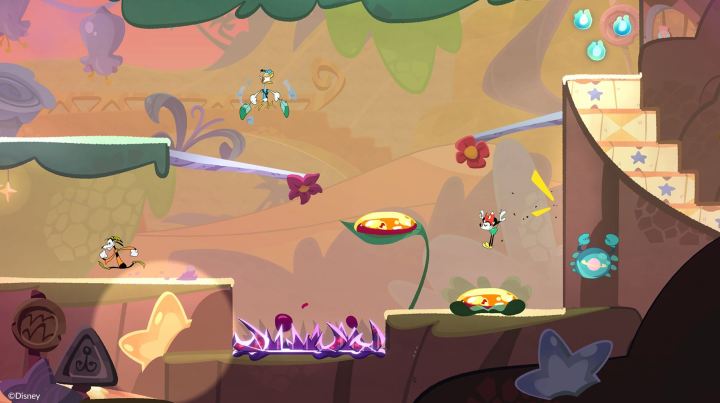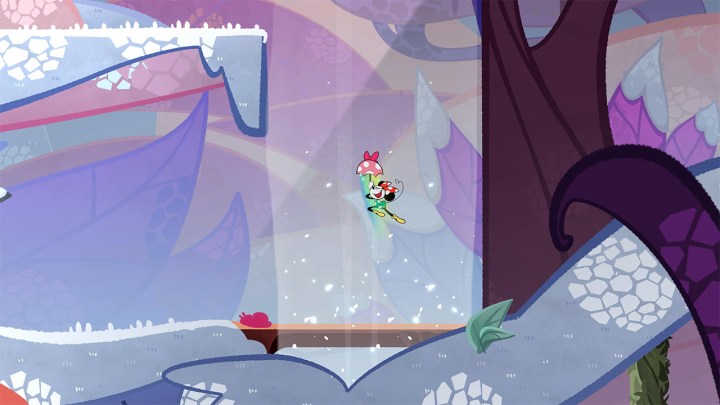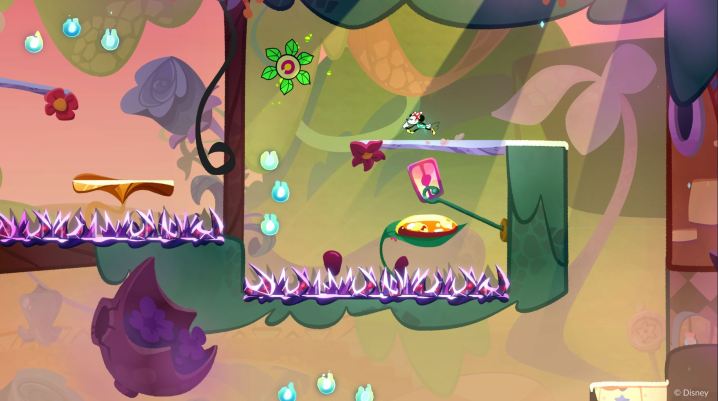
“Disney Illusion Island is a charming all-ages platformer that acts as a breezy introduction to the Metroidvania genre.”
- Gorgeous art
- Approachable gameplay
- Helpful co-op mechanics
- Accessibility options
- Narrative delivery
- Not as fun for experienced players
My first introduction to many game genres I love today came from licensed titles. Batman: Arkham Asylum showed me how to appreciate a well-designed Metroidvania, 2005’s Star Wars: Battlefront II introduced me the joys of a fun multiplayer shooter, and my love of simple and satisfying beat ’em ups comes from the Game Boy Advance spinoff Justice League Heroes: The Flash. These might not be the best games of their respective genres, but they stuck to their guns and showed a kid like me the deeper level of enjoyment that comes from playing video games.
That’s why I respect Disney Illusion Island. It may not interest adults, but it’s going to be a formative game for some kid in the same way Justice League Heroes was for me. The new Disney game from Battletoads developer Dlala Studios is a Metroidvania that removes combat and any other roadblocks that might get in the way of a young kid or inexperienced gamer. In fact, it actively includes some gameplay mechanics and accessibility options to help players in need. It’s a welcoming adventure that fits the Disney ethos.
Disney Illusion Island is not the most narratively exciting or mechanically deep Metroidvania out there. Still, entry-level games like this are just as crucial for the genre as steppingstones that someone can play before delving into the likes of Hollow Knight and Metroid Dread.
Monoth calls
In Disney Illusion Island, beings from a land called Monoth convince Mickey, Minnie, Donald, and Goofy to help them recover powerful tomes scattered throughout the land. This, along with the group’s desire to become heroes, serves as the simple backbone for the 2D platforming adventure. Illusion Island isn’t a Metroidvania that emphasizes lore and environmental storytelling like Metroid Dread; it wears its heart on its sleeve and mainly focuses on delivering wonderful aesthetics. The 2020 game Battletoads impressed with its distinct style, but Illusion Island adapts the expertly crafted visuals and sound design of the most recent Mickey Mouse shorts, making an adventure that’ll be instantly recognizable and attractive to those who like the cartoons.

That pleasant look pairs nicely with its easygoing gameplay; players of all skill levels should find it surprisingly fluid and fun. At the start of the adventure, players only have top focus on perfecting one skill: jumping. As the story progresses, their toolset expands with new abilities like wall jumping, ground-pounding, gliding, swinging, rail grinding, and diving. All of those are represented through playfully designed items that fit each character’s personality (Donald routinely gets the short end of the stick with hastily cobbled-together upgrades while Mickey gets top-tier tech).
If you’ve played a 2D platformer before, none of these mechanics will surprise you. However, Illusion Island‘s unique twist is that it doesn’t feature any sort of combat. The fact that all four characters play exactly the same means the focus is solely put on movement and platforming. While it starts a little simple, the eventual fun comes from chaining together each ability to complete bite-sized platforming challenges that always feel manageable.
Illusion Island boils down all of these controls to a two-button setup that’s simple enough that almost anyone can understand them. However, more hardcore players will appreciate how seamlessly every move players have at their disposal flows into each other.
For the kids
The adventure paces out new abilities well throughout its adventure to not overwhelm players. In general, Dlala made a lot of design decisions here to keep Illusion Island as approachable as possible. It encourages co-op play and is best played that way. In co-op, several mechanics directly exist to allow players to help one another. Players can hug to give each other extra help, put down a rope their partner can climb up Spelunky-style, and even get a jump boost by leapfrogging over each other.
Those options seem like they would be beneficial for a parent planning to play Illusion Island with a young child.
I played a bit with my brother, and even though he’s an experienced gamer, these were still fun mechanics to utilize while playing with him in co-op. Upon further experimentation, I discovered more accessibility mechanics that make jumping and clinging to walls easier for players who may struggle to do those things. All of those options seem like they would be beneficial for a parent planning to play Illusion Island with a young child.
Still, knowing the formative impact licensed games like this can have on a kid and seeing all of the systems working together to make sure that this an enjoyable experience for everyone makes me much more appreciative of those aspects of Illusion Island’s design. The only piece that feels at odds with this design is how Illusion Island delivers most of its narrative. There are some fully animated and voice-acted cutscenes, but these are mainly at the start and end of the game. For most of its runtime, the story plays out entirely in text boxes.

While there are a couple of good text-based gags, I can’t imagine the young kids will care to sit through and actually read most of these, especially in the lengthier conversations. More visual gags or voice-over could have helped to keep the experience a little more universal. As it stands, older players will be the ones who get the most out of Illusion Island’s writing and narrative, which feels a bit out of step with other aspects of the game’s design.
For the adults
While I’ve talked a lot about how approachable Illusion Island is, it still features all of the trademarks of a good Metroidvania game. Most Metroidvanias draw from the design of games like Super Metroid and Castlevania: Symphony of the Night, letting players loose on a gigantic map they can explore more of as they gain new abilities that open up access to new areas. Illusion Island’s Monoth is set up just like that, as the adventure unfolds across one gigantic 2D map (with many secrets) that opens up as players gain new abilities.
It’s a breeze to get through Illusion Island; whether that’s a deal breaker is up to you.
On the genre’s spectrum, Illusion Island is on the linear side, as exploration mostly just rewards players with collectibles like the health-upgrading Glimts, Tokuns that reveal more about the game’s characters, and Mickey Memorabilia that calls back to Disney shorts. The game’s map does a great job of noting where players have been, where they haven’t been, and where there are items to collect, making Illusion Island a solid game for up-and-coming completionists.
Illusion Island’s map also must accommodate the design conceit that there is no enemy combat. That plays up the obstacle course feel of Illusion Island’s level design, as the fun of getting through an area is less about wondering whether or not you can overcome a challenge, but instead about learning to make the right moves in the correct order to succeed. That plays into making this one of the most approachable Metroidvanias out there, although that may ultimately become a shortcoming for more experienced players.

The adventure is on the shorter side at around 7 to 10 hours, depending on how thoroughly you want to explore and collect objects. The game always tells players exactly where they need to go and what needs to be done to progress, and none of the platforming challenges will match the intensity of dodging an E.M.M.I. in Metroid Dread or even the more complex level design of a title like Celeste or Donkey Kong Country: Tropical Freeze. And if you’re playing Illusion Island by yourself, there aren’t any interesting single-player mechanics to make up for the lack of co-op abilities like hugging.
It’s a breeze to get through Illusion Island; whether that’s a deal breaker is up to you. Ultimately, the game is too on the simplistic side for me, which prevents me from placing Illusion Island with the platforming greats. Still, I recognize from many of the systems present and the subject matter that Illusion Island isn’t primarily tailored to my skill level and experience.
Disney Illusion Island‘s goal is to ease new players into the Metroidvania genre with recognizable characters, helpful co-op mechanics, and a charming visual style and soundtrack. The game does pull that off, so while this probably won’t be a title I will remember fondly a few years from now, I could see it being a gateway to Metroidvania or gaming as a whole for a kid who wants to play a game starring his favorite Disney character.
Disney Illusion Island was reviewed on Nintendo Switch.




